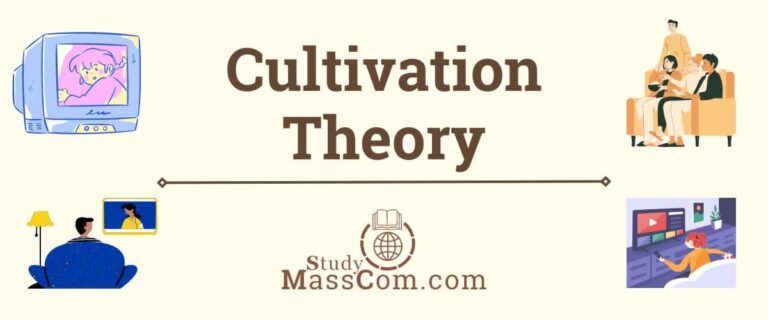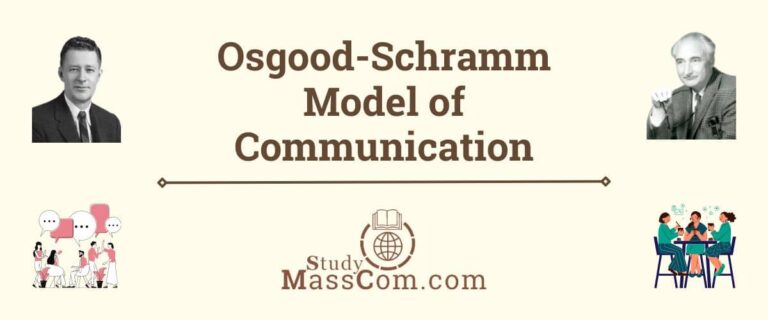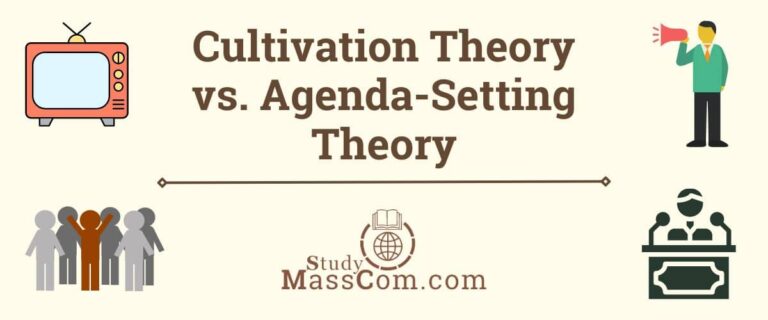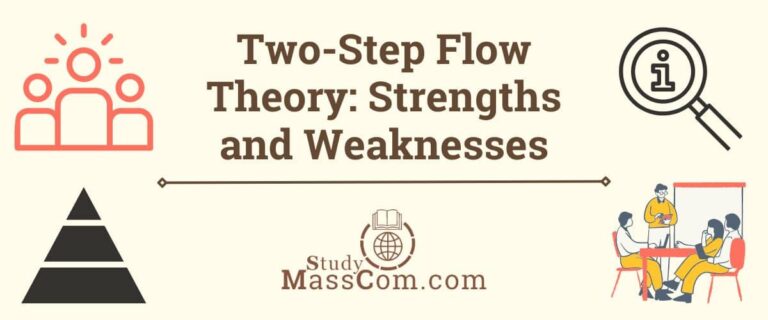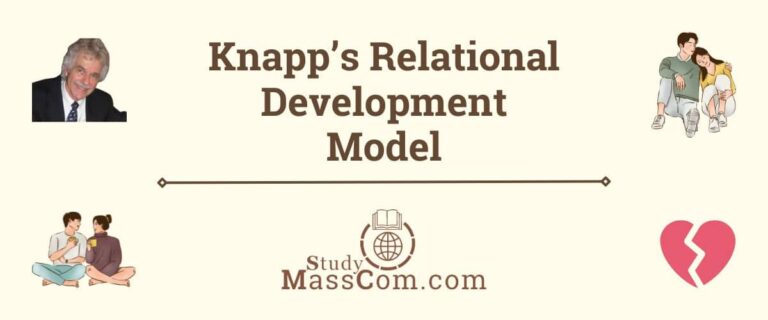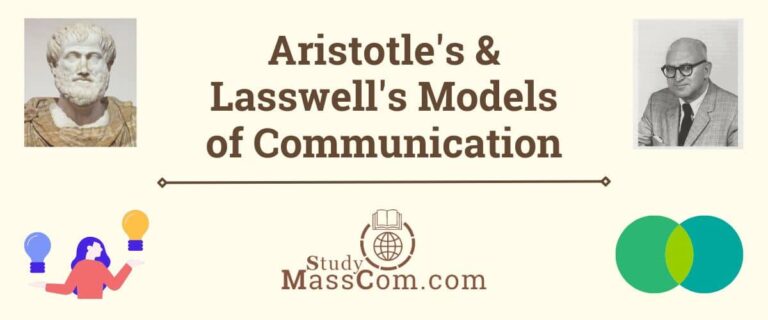Wilbur Schramm’s Model of Communication: Advantages & Disadvantages
Wilbur Schramm, a pioneering figure in communication studies, developed a comprehensive model of communication that has significantly influenced the field. His model is notable for its emphasis on the interactive nature of communication and its recognition of the various elements and factors that contribute to effective communication processes. In this article, we will discuss Wilbur Schramm’s model of communication in detail, exploring its components, principles, and relevance in contemporary communication theory and practice.

Historical Context and Background of Schramm’s Model of Communication
Before delving into Schramm’s model, it’s essential to understand the historical context in which it emerged. Schramm was a key figure in the development of communication studies during the mid-20th century, a time marked by rapid technological advancements and increasing interest in understanding human communication. As a scholar and researcher, Schramm sought to create a framework that could encompass the complexity of communication processes and their impact on individuals and societies.
Definition of Schramm’s Model of Communication
Wilbur Schramm’s model of communication is a theoretical framework that depicts communication as a dynamic and interactive process involving the exchange of messages between senders and receivers. Unlike earlier linear models, Schramm’s model emphasizes the reciprocal nature of communication, highlighting the active roles played by both parties in encoding, decoding, and responding to messages. The model consists of several key components, including the source (sender), message, channel, receiver, feedback, and noise, which collectively contribute to the transmission and interpretation of information. Schramm’s model underscores the multidimensional and adaptive nature of communication, acknowledging factors such as context, culture, and individual differences that influence the effectiveness of communication interactions. Overall, Schramm’s model provides a comprehensive framework for understanding the complexities of human communication processes.
Key Components of Wilbur Schramm’s Model of Communication
Source
The sender or source initiates the communication process by encoding a message. This could be an individual, group, organization, or any entity that wishes to convey information.
Message
The encoded information or content transmitted by the source. The message can take various forms, including verbal, nonverbal, written, or visual communication.
Channel
The medium through which the message is transmitted from the source to the receiver. Channels can be verbal (e.g., speech), nonverbal (e.g., body language), or mediated (e.g., television, internet).
Receiver
The recipient or audience who receives the message. Receivers interpret and decode the message based on their knowledge, attitudes, beliefs, and cultural context.
Feedback
The response or reaction of the receiver to the message. Feedback completes the communication loop by providing the sender with information about the effectiveness of their message.
Noise
Any interference or distortion that disrupts the communication process. Noise can be internal (e.g., psychological factors) or external (e.g., environmental distractions), affecting the clarity and accuracy of the message.
Learn about the Shannon-Weaver model.
Features of Wilbur Schramm’s Model
Interactivity
Schramm’s model emphasizes the interactive nature of communication, highlighting the continuous exchange of messages between senders and receivers. Communication is viewed as a dynamic process involving feedback and adaptation.
Transactional
Communication is seen as a transactional process where both parties (sender and receiver) play active roles. Each participant contributes to the meaning-making process through encoding, decoding, and feedback.
Multidimensional
Schramm’s model recognizes the multidimensional nature of communication, considering various factors such as context, culture, and individual differences. Communication is not solely about the transmission of information but also about the interpretation and negotiation of meaning.
Adaptive
Communication is adaptive and context-dependent, meaning that it evolves and adjusts based on the specific situation, goals, and participants involved. Effective communication requires flexibility and responsiveness to changing circumstances.
Check out Berlo’s SMCR model of communication.
Field of Experience in Schramm’s Model of Communication
In Wilbur Schramm’s model of communication, the “field of experience” refers to the shared background, knowledge, attitudes, and cultural context that both the sender and receiver bring to the communication encounter. This concept emphasizes that individuals interpret messages based on their own unique experiences and perspectives, which can significantly influence the encoding and decoding of information.
Schramm recognized that communication does not occur in a vacuum but is deeply embedded within the broader context of individuals’ lived experiences. The field of experience encompasses various factors, including:
Cultural Background
Cultural norms, values, beliefs, and traditions shape individuals’ understanding of communication. Different cultural backgrounds can influence how messages are interpreted and decoded by receivers.
Educational and Socioeconomic Background
Educational level, socioeconomic status, and life experiences contribute to individuals’ knowledge base and worldview. These factors can influence their comprehension of messages and their ability to relate to the content being communicated.
Personal Beliefs and Attitudes
Personal beliefs, attitudes, and biases play a crucial role in how individuals interpret and respond to messages. People tend to filter incoming information through their existing beliefs and attitudes, which can affect the reception of the message.
Social Identity
Factors such as gender, ethnicity, religion, and social identity shape individuals’ perceptions and interpretations of communication. People may identify more strongly with messages that resonate with their social identity and experiences.
Interpersonal Relationships
Previous interactions and relationships between the sender and receiver can impact communication dynamics. Trust, familiarity, and relational history influence how messages are received and interpreted.
Contextual Factors
Environmental, situational, and relational contexts also contribute to the field of experience. The physical environment, timing of the communication, and social dynamics all play a role in shaping individuals’ interpretations of messages.
In Schramm’s model, the field of experience underscores the importance of considering the diverse backgrounds and perspectives of both the sender and receiver in communication interactions. It highlights that effective communication requires an understanding of the shared context within which messages are exchanged and interpreted. By acknowledging the influence of individuals’ experiences and backgrounds, communicators can strive to craft messages that resonate with their audience and facilitate meaningful understanding and engagement.
Learn about Aristotle’s communication model and its pros and cons.
Advantages and Strengths of Wilbur Schramm’s Model of Communication
Wilbur Schramm’s model of communication offers several advantages that contribute to its enduring relevance and utility in the field of communication studies. Some of these advantages include:
Interactivity
In today’s digital age, interactive communication platforms such as social media, online forums, and instant messaging have become prevalent. Schramm’s model emphasizes the interactive nature of communication, highlighting the continuous exchange of messages between senders and receivers. This recognition of interactivity aligns with the reality of communication in contemporary settings, where feedback, dialogue, and engagement play crucial roles in shaping communication dynamics.
Transactionality
Unlike earlier linear models that depicted communication as a one-way process, Schramm’s model views communication as a transactional process where both parties (sender and receiver) play active roles. This transactional perspective acknowledges that communication involves mutual influence and reciprocal interaction between participants.
Feedback Mechanisms
Schramm’s model highlights the importance of feedback in the communication process, enabling senders to gauge the effectiveness of their messages and make necessary adjustments. By incorporating feedback mechanisms such as responses, reactions, and evaluations, the model facilitates continuous improvement and refinement of communication strategies.
Multidimensionality
With advancements in technology, communication has become increasingly multimodal, incorporating various forms of media such as text, images, videos, and audio. Schramm’s model recognizes the multidimensional nature of communication, considering various factors such as context, culture, and individual differences. By acknowledging the complexity of communication, the model provides a more holistic framework for understanding how messages are encoded, decoded, and interpreted within diverse social and cultural contexts.
Cultural Sensitivity
Schramm’s model acknowledges the influence of culture on communication dynamics, emphasizing the importance of cultural sensitivity and understanding in effective communication. By considering cultural norms, values, and practices, communicators can enhance the relevance and impact of their messages across diverse cultural contexts.
Adaptability
In a rapidly changing environment, communication strategies need to be adaptive and context-specific. Communication is inherently adaptive and context-dependent, and Schramm’s model reflects this by emphasizing the need for flexibility and responsiveness in communication strategies. By recognizing the dynamic nature of communication, the model encourages communicators to tailor their messages and approaches to the specific needs and preferences of their audience.
Practical Applicability
Schramm’s model offers a practical framework that can be applied across various communication contexts, including interpersonal, organizational, mass media, and digital communication. Its flexibility and adaptability make it suitable for analyzing and understanding communication processes in a wide range of settings and situations.
Overall, the advantages of Wilbur Schramm’s model of communication lie in its recognition of interactivity, transactionality, multidimensionality, adaptability, feedback mechanisms, cultural sensitivity, and practical applicability. These qualities contribute to the model’s enduring relevance and utility in both theoretical analysis and practical application within the field of communication studies.
Read about the advantages and disadvantages of Transaction model of communication.
Disadvantages and Criticism of Wilbur Schramm’s Model of Communication
While Wilbur Schramm’s model of communication offers valuable insights into the communication process, it is not without its limitations and criticisms. Some of the disadvantages of Schramm’s model include:
Simplicity and Oversimplification
Schramm’s model is relatively simplistic compared to more elaborate communication models developed in later years. Critics argue that it oversimplifies the complexities of communication by focusing primarily on the exchange of messages between senders and receivers. It may overlook other important factors that influence communication, such as power dynamics, social structures, and historical contexts.
Lack of Context
The model does not explicitly address the broader socio-cultural, political, and economic contexts that shape communication dynamics. In real-world situations, communication is influenced by a multitude of contextual factors that are not adequately accounted for in Schramm’s model.
Linear Representation
Although Schramm’s model is often depicted as a circular process, it retains a somewhat linear structure with a clear sender-receiver orientation. This linear representation may not fully capture the recursive and nonlinear nature of communication interactions, especially in complex communication environments.
Limited Emphasis on Power Dynamics
The model does not extensively address power dynamics and inequalities that may exist within communication interactions. Issues related to power, privilege, and marginalization are increasingly recognized as important considerations in communication scholarship, yet Schramm’s model may not explicitly address these dynamics.
Limited Focus on Media Effects
While Schramm’s model acknowledges the role of mass media in communication, it may not provide a comprehensive framework for understanding media effects and the ways in which media messages influence individuals and society. Subsequent theories and models, such as the cultivation theory and agenda-setting theory, have expanded on Schramm’s model to address these issues more explicitly.
Overemphasis on Feedback
While feedback is an essential component of communication, Schramm’s model may overemphasize the role of feedback in the communication process. In some communication contexts, such as mass media or public speaking, immediate feedback may be limited or absent, leading to a less nuanced understanding of communication dynamics.
Cultural Specificity
Schramm’s model may not adequately account for cultural variations in communication patterns and preferences. Communication styles, norms, and values vary across cultures, and Schramm’s model may not fully capture these cultural differences in its framework.
Overall, while Wilbur Schramm’s model of communication provides a valuable starting point for understanding communication processes, it is important to recognize its limitations and consider additional factors and perspectives in analyzing communication dynamics. Subsequent theories and models have built upon Schramm’s work to offer more nuanced and comprehensive frameworks for studying communication in diverse contexts.
Also, check out the differences and similarities between Shannon-Weaver and Transaction models.
Examples of Schramm’s Model of Communication
To illustrate Schramm’s model of communication, let’s consider a few examples:
Face-to-Face Conversation
Source: A person initiating a conversation.
Message: Verbal and nonverbal cues such as words, tone of voice, facial expressions, and gestures.
Channel: Direct verbal communication between individuals.
Receiver: The person or people listening and responding to the message.
Feedback: Immediate responses from the receiver, such as nodding, smiling, or verbal replies.
Noise: Distractions in the environment, such as background noise or interruptions.
Email Communication
Source: An individual composing an email.
Message: Written content conveyed through the email, including language, tone, and formatting.
Channel: Email platform used to send and receive messages electronically.
Receiver: The recipient reading and interpreting the email.
Feedback: Replies or responses from the recipient, indicating their understanding or additional questions.
Noise: Technical issues, misunderstandings due to ambiguous language, or distractions while reading the email.
Television Broadcast
Source: Television network broadcasting a program.
Message: Audiovisual content including dialogue, visuals, music, and effects.
Channel: Television transmission reaching viewers’ homes through broadcasting or cable/satellite.
Receiver: Viewers watching the program on their television sets.
Feedback: Viewer ratings, social media comments, or audience surveys providing feedback on the program.
Noise: Interruptions due to technical glitches, competing programs on other channels, or distractions in the viewing environment.
Social Media Interaction
Source: An individual posting content on a social media platform.
Message: Text, images, videos, or links shared as a post or message.
Channel: Social media platforms (e.g., Facebook, Twitter, Instagram) used for sharing and receiving content.
Receiver: Friends, followers, or the public viewing and engaging with the content.
Feedback: Likes, comments, shares, or direct messages from other users in response to the post.
Noise: Information overload, algorithmic filters affecting content visibility, or online trolls and negative comments impacting the communication process.
In each of these examples, we can see how Schramm’s model applies to different communication contexts, highlighting the interactive nature of communication and the various elements involved in the exchange of messages between senders and receivers. The model helps to analyze and understand communication processes across diverse channels and settings, emphasizing the importance of considering factors such as feedback, noise, and the field of experience in effective communication.
Learn more about the Uses and Gratification Theory.
Conclusion
Despite its limitations, Wilbur Schramm’s model of communication remains a foundational framework in the field of communication studies. Its emphasis on interactivity, transactionality, and multidimensionality has influenced subsequent theories and approaches to understanding communication processes. As communication continues to evolve in response to technological, social, and cultural changes, Schramm’s model provides a solid foundation for analyzing and interpreting the complexities of human interaction through communication.
Explore Wilbur Schramm’s Magic Multiplier Theory.
FAQs
Schramm’s model of communication is a circular framework emphasizing the interactive exchange of messages between senders and receivers. It includes elements such as the source (sender), message, channel, receiver, feedback, and noise, highlighting the multidimensional and adaptive nature of communication. The model recognizes the role of context, culture, and individual experiences in shaping communication interactions. Schramm’s model emphasizes interactivity, transactionality, and the importance of feedback in effective communication processes. While providing a foundational understanding of communication dynamics, the model has been critiqued for its simplicity and limited attention to broader contextual and power dynamics.
The purpose of Schramm’s Model of Communication is to provide a conceptual framework for understanding the dynamic and interactive nature of communication processes. By identifying key components such as the source, message, channel, receiver, feedback, and noise, the model aims to elucidate how messages are transmitted, interpreted, and responded to within various contexts. It emphasizes the importance of feedback and adaptation in effective communication and highlights the multidimensional factors that influence communication interactions. Overall, the model serves as a tool for analyzing communication dynamics and facilitating the study of human interaction through the exchange of messages.
Wilbur Schramm’s Model of Communication operates by depicting communication as a dynamic and interactive process involving multiple components. It begins with a sender encoding a message, which is transmitted through a chosen channel to a receiver. The receiver then decodes the message and provides feedback, completing the communication loop. Throughout this process, various factors such as noise and the field of experience influence the effectiveness of communication. The model emphasizes the reciprocal nature of communication, highlighting the continuous exchange of messages between senders and receivers, and underscores the importance of feedback in shaping communication dynamics.
An example of Schramm’s Model of Communication in real life is a conversation between friends. The sender (Friend A) initiates the communication by encoding a message, which could be verbal (spoken words) or nonverbal (facial expressions, gestures). The message is transmitted through the channel of face-to-face interaction. Friend B, the receiver, decodes the message, interprets its meaning based on their field of experience, and provides feedback through verbal responses or nonverbal cues. Throughout the conversation, external noise such as background chatter or distractions may impact the clarity of the message, highlighting the interactive and dynamic nature of communication.
In Schramm’s Model of Communication, accumulated experience refers to the collection of knowledge, beliefs, attitudes, and cultural background that individuals bring to the communication process. This concept recognizes that individuals interpret and respond to messages based on their past experiences and learning. Accumulated experience influences how messages are encoded by the sender and decoded by the receiver, shaping the meaning-making process. It encompasses personal experiences, education, social interactions, and cultural upbringing, which collectively contribute to the field of experience within which communication occurs. Understanding accumulated experience is essential for effective communication, as it influences individuals’ perceptions and interpretations of messages.

